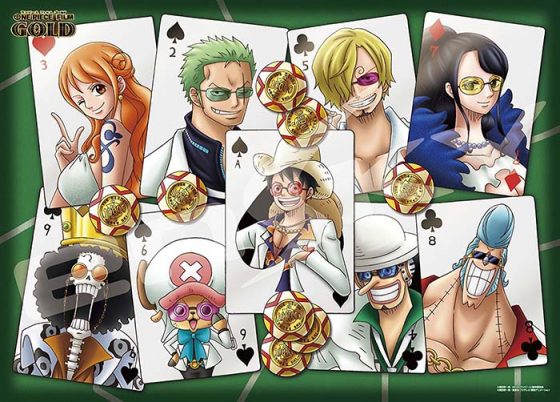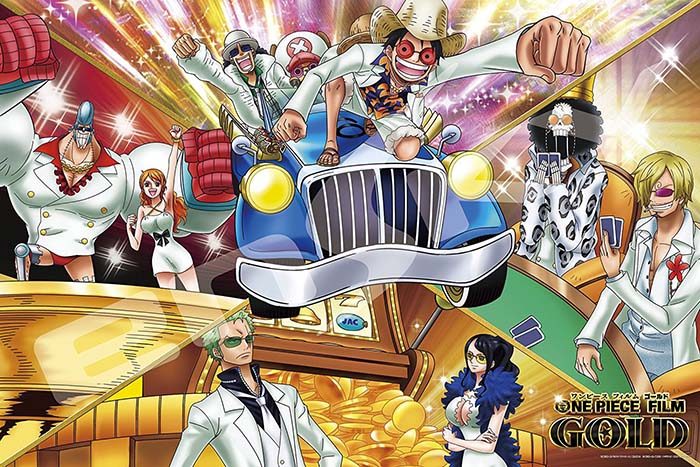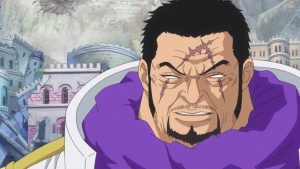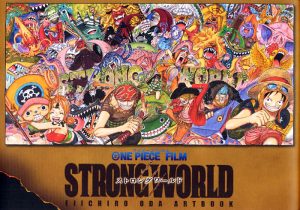- Genre : Action, Adventure, Comedy
- Airing Date : July 23rd, 2016 (Japan), January 10th, 2017 (USA)
- Studios : Toei Animation
Contains Spoilers
The Straw Hat Pirates are back in a new theatrical release! This time, Luffy and the gang arrive at Grantesoro, a gigantic resort ship dedicated to the sole amusement and fun of its visitors that’s so large it’s actually considered its own nation! At first, the crew, particularly Nami, is excited to be there due to the promise and thrill of winning wealth beyond their wildest dreams until they discover they’ve actually been duped by the ship’s captain, Tesoro, into betting and losing all their winnings in one game, all just in order to mess with them and force them to become slaves on his ship. While they try to fight their way out of it, Tesoro, with the ability to manipulate gold, actually coated them with gold dust when they first entered the city and can encase them in gold at any time he chooses, using Zoro as an example. Tesoro agrees, however, that if they can pay back the 300 million Berries they owe him for their loss by the next evening, he’ll free Zoro and let them leave his ship.
Nami, lost as to what to do, has a chance meeting with an old friend of hers by the name of Carina, a fellow thief from the East Blue who betrayed Nami and left her for dead. However, Carina has been working within Tesoro’s hidden circle and has discovered that he actually holds about 20% of the world’s currency within his vault and has been working a long con to gain access to this incredible wealth. Nami and Carina agree to set aside their differences to work together to infiltrate Tesoro’s tower and steal the money that Nami needs to save Zoro. Nami and Carina agree on a plan where the two of them, along with Usopp, Brook, Robin, Sanji, and Chopper make their way through the tower while Luffy and Franky climb around outside to the top to shut down the surveillance system.
Unfortunately though, Luffy and Franky get caught while trying to sneak in, and the two get thrown into a golden city in the depths of the ship, where they discover that Tesoro has been holding prisoners without any food or water. They meet a legendary gambler who points them to where they can find seawater in order to wash off the gold. Meanwhile, Nami and her group manage to make their way to the vault only to discover it was a trap set by Tesoro meant to mess with them, and Carina was just leading them on while working for Tesoro the whole time.
When all hope seems lost, the power shuts off suddenly and seawater, along with Luffy and co., comes bursting out of the giant pipe! Nami reveals that she actually knew that Tesoro was planning on luring them here and no one is forced to be under his control anymore, as the gold dust that gets sprinkled on every citizen of Grantesoro has been washed away. In a fit of rage, Tesoro begins attacking the city, along with his minions Tanaka, Dice, and Baccarat. It’s revealed to the viewer that Tesoro values his wealth due to a complex over his extremely poor upbringing forcing him to be sold into slavery by the Celestial Dragons, the elite citizens of the world, and wants to control everything like they controlled him. Luffy and the gang fight and eventually bring Tesoro and his group down, Tesoro himself getting launched onto a marine ship headed by none other than Rob Lucci, a former foe of Luffy’s, who was there to stop Tesoro himself but was halted by Luffy’s brother Sabo, who didn’t appreciate that Lucci’s plan involved sacrificing civilians. The movie ends with Carina stealing Grantesoro, though she and Nami have an understanding and bear no ill will towards each other, knowing that each is just acting in their own way.
What I Liked About One Piece: Film Gold

Film Gold manages to convey a lot in its relatively short running time through the use of its visuals and creative editing techniques. For example, a common recurring trope in the main line series is its extended flashback sequences, which can at times run for several episodes or chapters that really get into the nitty gritty of the events that shaped a character’s history. For its villain Tesoro, however, rather than have an extended, in-depth flashback, we get a sequence with blurred out visuals and quick cuts between still shots with characters talking over the stills as if these are memories that are trying to be silenced but won’t go away. We get a lot of information in this sequence, about how he lived, and how he met a captured girl who inspired him to never be brought down by anyone; to his own enslavement and his eventual escape, and where his signature “star” imagery came from. We get all of this over the course of about a minute, and we get a lot of evocative imagery and information about what has shaped Tesoro without hurting the pacing of the film.
Of course, there’s also that signature One Piece humor that keeps us grounded in the film without feeling overloaded by the drama and the action. Film Gold maintains the series’ style of humor while staying true to its own format. A great example of this is during Luffy’s infiltration into the main camera room. At first, we see in a continuous long shot how he carefully stretches down from a vent, only to quickly retreat once the guard in the foreground is about to turn back around. It cuts back to the vent with some dialogue between Luffy and Franky, and then the camera cuts back to Luffy stretching back down, the guard no longer visible. Franky keeps calling out to Luffy while Luffy wraps his legs around the rather large cable, and Franky calls out to Luffy again. Luffy asks what’s wrong, and then we get a cut to a similar shot when Luffy was first stretching down, only this time the guard is actually looking straight at Luffy. There’s a pause of the two characters just staring at one another, and then a cutaway with a blaring of sirens. The frequent cuts and obscuring of the camera is a style that is fairly unique to film due to its reliance on movement, and the film manages to use the medium to accurately replicate the main series’ style.
Discussion Time: Should You Watch One Piece: Film Gold?
【宣伝staff】JOYSOUNDにてコラボキャンペーン実施!
アニメカラオケを歌って、豪華賞品をGETしよう! #OPFG 詳細はこちら!→https://t.co/w7utcVYui2 pic.twitter.com/ByG7BfP0Qx— ワンピースフィルムゴールド【公式】 (@OP_FILMGOLD) July 20, 2016
This is a film that does a great job of capturing the feeling of the One Piece anime and manga and adapting it to a blockbuster movie. There’s a lot of explosive action in this movie, whether it’s the grand final faceoff between Luffy and Tesoro, or even the very beginning of the film where Luffy, Usopp, and Chopper race a car just for the heck of it. Fans of the series will feel right at home with the tone it establishes. And, heck, while Grantesoro isn’t canon, it’s Las Vegas-type night show theming is about as exotic of a locale as any found in the mainline series and wouldn’t feel out of place at all in the main story.
That being said, if you’re not already a fan of One Piece, Film Gold isn’t going to do much for you. This is a movie written and designed for people who are already deeply invested in the series, requiring a great deal of knowledge about character relationships and terminology. For example, one of the reasons why Tesoro is a threat is because he has an Awakened Devil Fruit. If you don’t already know what that sentence means, then chances are you’re not the target audience of this movie. Film Gold isn’t about to change anyone’s opinion of the series.
映画の公開までついにあと一か月!!!みなさんエンターテインメントシティへの出航準備はできてますか?! pic.twitter.com/UUCReYati7
— ワンピースフィルムゴールド【公式】 (@OP_FILMGOLD) June 23, 2016
1. Impressive Scale
One Piece has always been a story about a big world and the even bigger personalities found within. This movie, perhaps more so than any other movie in the franchise, really captures that sense of grandeur that One Piece is known for. A lot of this comes from the camera work. There are a lot of extreme long shots that have the characters framed against giant structures. A great early example of this is when the Strawhat pirates leave their ship, the trusty Thousand Sunny, and enter Grantesoro. The shot stays relatively far away from this brief action and allows you to take in the scenery while Luffy stands in front of the hall as a reference point. This immediately communicates to you just how big and grand this ship is without having to beat you over the head with exposition. It’s a big story, and, most importantly, it feels big.
2. Creative Action Scenes
Naturally, this wouldn’t be a One Piece story without some crazy devil fruit powers with a touch of aplomb. Film Gold does not disappoint in this regard. Tanaka pops in and out of the floor shooting like mad as if he’s part of a devilish game of whack-a-mole. Baccarat uses her luck powers to create Rube Goldberg-like sequences with seemingly inconsequential items that end up with catastrophic results for Usopp. Tesoro isn’t satisfied with simply coating himself in gold, but actually building a gigantic golden monument of himself and controlling it like a mecha. It’s wonderfully absurd and half the fun is just seeing what crazy stunt any of the characters pulls next.
While One Piece is largely defined by its bombastic action, it tends to lean a bit too much on that for its big moments. However, it’s not just the insane powers that make a fun watch. You get plenty of that too, but Film Gold is refreshing because it also mixes things up a bit by setting up the first half of the film as a heist movie. We get to watch the Strawhat Pirates a bit out of their element and have a bit more creative usage of their powers, like Chopper being able to speak to animals in order to cross a room of surveillance owls that call out where they’re going to look next, or Franky using his chain arms to scale a building without being seen. It’s more inventive than the series usually gets with its main characters’ abilities, which gives Film Gold a refreshing feel.
3. Most Everyone Has a Role
Most of the time in One Piece, the series ends up giving most of the action and active work to Luffy, Zoro, and Sanji, with occasionally the other characters getting some other work to do while the Monster Trio take care of the major threats. While these 3 still get their big fights in the end, the first half or so of the movie actually gives Nami a pretty active role in the story, and the core emotional connection of the story is actually set up via her past with Carina and watching these two mend their friendship back together via a common goal. Not only that, but Nami is key in the development of the main plan of the heist. Plus, Usopp gets a pretty big role in the defeat of Baccarat (someone neither Luffy nor Sanji could beat), Chopper gets his opportunity to shine with the aforementioned sequence with the owls; and even Robin, who tends to get ignored in big battle sequences, is pivotal in stopping Tanaka. Anyone who’s a fan of the series will appreciate that pretty much all the Strawhats at least get something to do.

1. Reused plot points
Fans of the main series may find it hard to ignore that the entire story of Film Gold takes a lot of its major story beats straight from the Dressrosa story arc of the manga and anime. Tesoro’s backstory may be succinctly told, his character and story is largely the same as Doflamingo’s, where he’s a gigantic control freak who developed a complex around the Celestial Dragons. Grantesoro may be well realized, but it’s effectively the same as Dressrosa, an idyllic paradise built on slavery that the World Government turns a blind eye to due to its influence amongst the Celestial Dragons. Heck, Sabo fighting Rob Lucci so he won’t get in the way of Luffy’s battle against Tesoro is effectively the same as when Sabo stepped in to stop Fujitora, another high ranking member of the World Government. While it’s well told, fans of One Piece may be let down to discover there’s actually very little material that the series has not already done.
2. Needs Extensive Knowledge of the Main Plot to Fully Understand
As stated over the course of this review, this is a movie for fans. A lot of this film is written assuming you already have a great deal of knowledge about all the different characters and their relationships with one another. For example, at one point of the film, Nami’s infiltration group dresses up as Celestial Dragons to intimidate the guards to give them free reign of the main hall. This plan, however, only makes sense if you understand going in the level of freedom and clout that Celestial Dragons hold in the world of One Piece. Or how about when Rob Lucci goes to ask Akainu for battleships to take to Grantesoro? If you don’t know that Akainu is the Fleet Admiral, then that might not make any sense to you. We could go on, but the point is that there’s not really a lot here for non-fans of the franchise.
Final Thoughts
Ultimately, One Piece: Film Gold is a great watch for any big fan of the series, and is absolutely worth seeing in theaters if you get the chance. However, if you’re not, there may not be much for you here. Maybe consider checking the manga or anime first and see if you like it, then catch it when it gets released on Blu-Ray!
Recommended Post
6 Anime Like One Piece [Updated Recommendations]
Recommended Post





